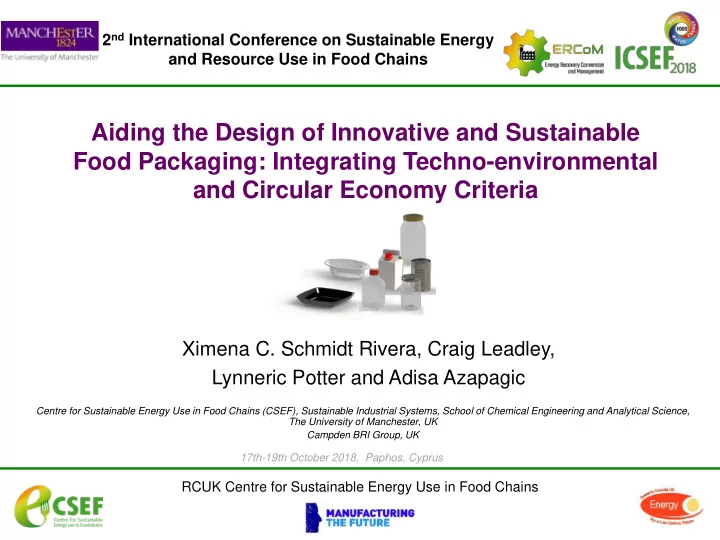

2 nd International Conference on Sustainable Energy and Resource Use in Food Chains Aiding the Design of Innovative and Sustainable Food Packaging: Integrating Techno-environmental and Circular Economy Criteria Ximena C. Schmidt Rivera, Craig Leadley, Lynneric Potter and Adisa Azapagic Centre for Sustainable Energy Use in Food Chains (CSEF), Sustainable Industrial Systems, School of Chemical Engineering and Analytical Science, The University of Manchester, UK Campden BRI Group, UK 17th-19th October 2018, Paphos, Cyprus RCUK Centre for Sustainable Energy Use in Food Chains
Outline • Introduction • Methodology • Results • Conclusions
Introduction • Food packaging has a multifunctional role: Container Protection of structural, nutritional and sensory Food losses aspects (Nutrients, resources, energy, Preservation water, land, GHG emissions) (health and safety) Promotion and information
Introduction Food waste: 1.3 billion tonne worldwide 7% of greenhouse gas emissions Plastic packaging: 72% are lost 26% of the total plastics 40% ending in landfills 32% in the ocean & urban areas 14% is recycled & after treatment only 5% of the material cost is retained
Introduction 1a. To increase recycling and 2a. Effective reuse; after-use management 1b. to collection, consider storage and alternative treatment; materials 2b. innovative design and materials that 3a. Help to encourage decarbonise after-use and the industry; reduce environmental 3b. increase impacts resource efficiency
Project aims • To develop key metrics to aid development and selection of new innovative food packaging congruent with the New Plastics Economy • Test using prototype packaging that promises to prolong food shelf life, reduce the amount of packaging and help avoid food waste along the supply chain • The packaging has a double-layer design, with an outer sealed quad containing a suspended inner cavity
Methodology Innovative food packaging • Food damage reduction • Shelf-life extension • Reduction of secondary packaging 1.Features Indicators for packaging selection New • Materials and energy plastics • End-of-life 2. CE economy • Direct and indirect LCA: new versus current packaging 3. LCA
Packaging features 1. Abuse test: • Transport vibration and drop tests 2. Shelf life test: • Modified atmosphere: high-oxygen atmosphere supplemented by carbon dioxide as an antimicrobial 3. Secondary packaging reduction test: • Crates loaded with the same number of layers for each packed product
Indicators Category Indicator Unit 1. Packaging features Food damage reduction % damage Shelf-life extension days Secondary packaging reduction units/crate 2. Circular economy Amount of material g/kg product Mono or multi components No./type Recycling content % Reuse rate times Current waste management I, L, C, R Current recycling rate % Potential recyclability % Use of renewable materials % Use of renewable energies % 3. Environmental impacts (LCA) Climate change kg CO 2 eq. Primary energy demand MJ Depletion of fossil fuels kg oil eq. Depletion of metals kg Cu eq.
Decision support guide
Results CPm Control CPm drop CPm crate CPm transit PPh Control PPh drop PPh crate PPh transit PPm Control PPm drop PPm crate PPm transit CPh Control CPh drop CPh crate CPh transit PP : prototype packaging; CP : current packaging; h : hand packed; m : machine packed
Results Prototype Current Category Indicator Unit packaging packaging Packaging Food damage reduction % damage 10-20% - features Shelf-life extension days 0 - Secondary packaging units/crate 8 9 reduction Circular g/kg Amount of material 88 91 economy product OPP/PE PET+ Mono or multi components No./type PP/EVOH PET film Recycling content % 0 0 Reuse rate times 0 0 Current waste management I, L, C, R I+L I+L Current recycling rate % 33% 33% Potential recyclability % 100% 100% Use of renewable materials % 0 0 Use of renewable energies % UK-grid UK-grid
Conclusions • The methodology exemplifies how to integrate the packaging technical performance with circular economy and life cycle thinking • This particular prototype does not show benefits in comparison with current packaging • But the methodology helps to identify improvement opportunities: Filling position vertical drop main responsible for damage Material selection mono component, low- carbon/renewable materials, higher recycling content & end- of-life management options Use of renewable sources electricity, heat Consider other products
Acknowledgement This work was carried out as part of the UK Centre for Sustainable Energy Use in Food Chains (CSEF), funded by the UK Research Councils (EP/K011820/1)
2 nd International Conference on Sustainable Energy and Resource Use in Food Chains Aiding the Design of Innovative and Sustainable Food Packaging: Integrating Techno-environmental and Circular Economy Criteria Ximena C. Schmidt Rivera, Craig Leadley, Lynneric Potter, Adisa Azapagic ximena.schmidt@manchester.ac.uk RCUK Centre for Sustainable Energy Use in Food Chains
Recommend
More recommend